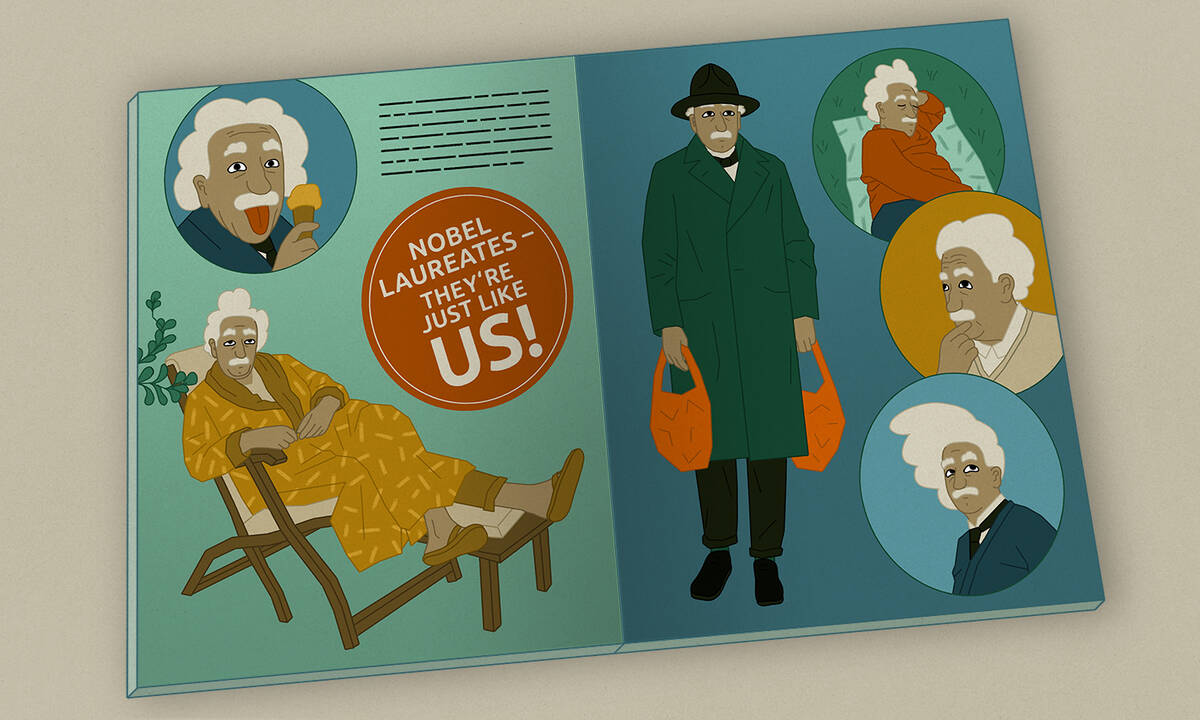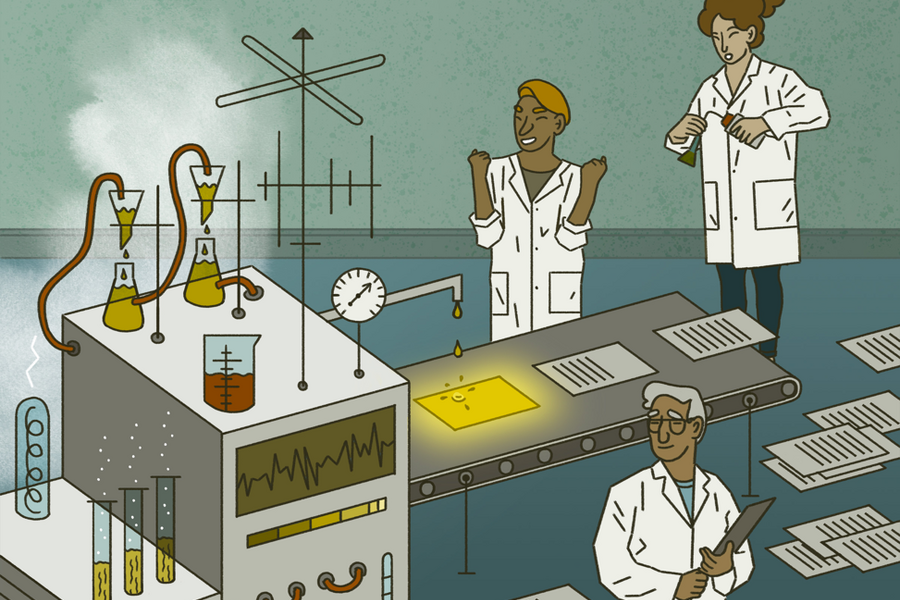On the face of it, there’s some evidence to support this idea: Einstein, for example, was just 26 when he formulated the theory of relativity—the publication that won him the Nobel Prize—seeming to justify his claim that, “A person who has not made his great contribution to science before the age of thirty will never do so.” Einstein was also the sole author of several of his most important publications, contributing to a view of breakthrough scientists as independent outsiders.
This perception has long left scientists wondering whether they should try to emulate Nobelists in their field, or whether those superstars are simply a breed of their own.
“While we can try to decipher the telltale signs of their success,” says Dashun Wang, associate professor of management and organizations at the Kellogg School, “one critical question has always lingered: Is their experience actually relevant to us? What if their careers are fundamentally different from ours, the mere mortals’?”
But new research from Wang challenges the conventional view of Nobel laureates as a rarified group whose careers follow essentially different patterns than those of other scientists. His analysis of the publications of more than a century of Nobel laureates in the sciences shows they are not, as a group, as precocious or as independent as we imagine them to be.
Many existing studies of Nobelists’ careers focus narrowly on the Prize-winning papers. But Wang and his coauthors—Jichao Li, a predoctoral fellow at Kellogg, Yian Yin, a PhD student at Northwestern’s McCormick School of Engineering, and Santo Fortunato of Indiana University—decided to look at the full sweep of Nobelists’ publication histories.
Taking this broader view, the researchers found evidence that Nobel laureates are more like other scientists than we usually imagine. They make important contributions throughout their careers, not just when they’re young, and they tend to partner with more collaborators than their peers, overall.
The True Characteristics of a Great Scientist
There is a pervasive myth that scientific genius and youth go together, with young scientists being more hungry and innovative than their older colleagues. But challengers to this view point out that later-career scholars have deep knowledge and years of practice at solving complex problems.
So who is correct?
In the debate over the merits of youth and experience, it turns out both sides are a little bit right and a little bit wrong. In a 2016 paper, Wang and other researchers discovered that the timing of when scientists publish their most significant papers—that is, those that are cited most often by other scientists—is random. In other words, a scientist is equally likely to have a hit paper at any point in his or her career.
But Wang and his coauthors wanted to know whether the “random-impact rule” applied to everyone. “Does this law discovered for normal scientists also apply for the scientific geniuses?” Yin wondered. “We know Nobel laureates are different from us, but to what extent are they different from us?”
To answer this question, the researchers gathered the entire career histories of nearly all Nobel laureates in physics, chemistry, and medicine from 1900 to 2016, and looked at the sequence of publications to see if any patterns emerged.
Initially, it seemed there might really be something to Einstein’s dictum. When the researchers looked at all of the papers that each Nobel laureate published before being awarded the Prize, they found that the Prize-winning paper (which is usually, though not always, the scientist’s most cited) did tend to occur disproportionately early in the sequence of papers—earlier than the random-impact rule would suggest. (This didn’t necessarily mean the scientists were young when they actually received the Prize—just that the paper that went on to win was published early.)
But when the researchers repeated the analysis with the Prize-winning papers removed, the pattern vanished. As a group, Nobelists’ careers looked like everyone else’s, with the most important papers occurring randomly throughout their careers.
Nobel Prize Winners: They’re Just Like Us!
Given this, why do Nobelists nonetheless tend to produce their Prize-winning works early in their careers?
It’s possible, of course, that youth provides a certain brand of creativity that’s necessary for producing groundbreaking science. But the researchers think it is more likely that the committees that award Nobel Prizes, and the norms surrounding the Prize, favor papers from early career scientists.
For instance, there tends to be a decades-long lag between the publication of the paper and the receipt of the Prize, and a Nobel Prize in science has never been awarded posthumously. “If you publish your most important paper as an early career scientist, you have more time to get your recognition,” explains Yin, “but if you publish your paper in your late 80s, it is less likely that you’ll live to get the Nobel.”
In other words, scientists who happen to publish their most influential work early on inadvertently give themselves more time, and therefore more opportunity, to win.
In this view, the scientific careers of geniuses and everyday scientists alike do follow the random-impact rule. It’s just that the lucky subset of scientists whose breakthrough publications happened to come early are more likely to become Nobelists.
Are Prize-Winning Scientists Really Loners?
The other side of the Nobel-laureate stereotype is that they tend to work alone, or in duos or trios. But the researchers wanted to test this theory as well. Because while Wang’s earlier researchsuggests solitary thinkers and small teams are most likely to have disruptive impact, it finds that many vital contributions have emerged from large, cross-institutional collaborations as well.
The researchers’ analysis did show a tendency for Nobel-winning papers to be published by smaller teams. In fact, about 60 percent of papers that got the Prize came from teams of three researchers or fewer—a noteworthy fact, given that papers with more authors tend to receive more citations overall.
“This is consistent with the results showing that small teams are more likely to produce disruptive science,” says Wang.
Yet, once again, if you remove the Prize-winning papers from the analysis, Nobel Prize winners begin to look much more like their peers.
A slight majority of Nobelists’ next most cited papers (57 percent) came from teams of more than three people. And overall, the average team size for Nobel laureates is slightly higher (4.04) than for non-laureates (3.25).
The propensity for Nobel-winning papers to come from small teams may indicate that, indeed, small teams produce more Nobel-worthy research. But, as with the early versus late-career debate, it’s also possible that factors related to the Prize itself could be tipping the scales: the Prize can only be awarded to three people per field each year. So perhaps when they realize they have a hit paper on their hands, scientists limit the number of coauthors in order to remain eligible for the Nobel, the researchers speculate.
Taken together, the research paints a surprising portrait of Nobelists as consistent and collaborative—brilliant thinkers, to be sure, but brilliant thinkers who may benefit from a bit of luck in the timing of their discoveries, and who recognize the value of teamwork.
Wang sees the results as lending hope to any scholar who dreams of being a Nobel laureate. “Perhaps these immortals of science are more similar to more ordinary scientists like us than we previously imagined,” he says.




